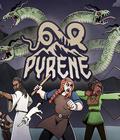In Pyrene, players choose a character and go into the fields to fight monsters and find loot. Upon reaching an endpoint or dying, players return back to their home village and lose almost everything except for valuable crafting materials. You can spend crafting materials on fixing up the village and unlocking new characters, weapons and items, thus providing an advantage on your next trip. It's nice and straightforward, right?
Each area in Pyrene is comprised of a series of connected tiles. When you enter the zone, the tiles are filled out with cards from your deck, enemy cards, and a series of other cards, depending on your location. Your objective is to move from tile to tile, clearing as many as you can, in search of an altar. Once you find the altar, the stage is over, but the game rewards you for staying as long as possible in a single area once the altar is discovered with better loot and rewards. However, you can only enter an occupied tile. If a tile isn't occupied, you can't enter it, and if there are no tiles to enter, then you're forced to rest.
Resting fills out the tiles again, but any monsters who were on the field gain an extra hit point for every rest period they're not killed. However, resting utilizes provisions, with each successive rest taking up more and more provisions. If you don't have enough, you take one damage point for every provision you're missing. While you can find more provisions from cards, there is effectively a soft time limit on how long it can take you to finish a stage, so it's essential to minimize the amount of time you spend on resting.
To fight enemies, you simply move your player-card into them, at which point they are defeated, and you take the amount of damage that the monster has as HP damage. If a monster has three points, you take three points of damage. Certain monsters have special attributes, such being able to poison you, reviving after death, or having armor. All defeated enemies drop a card, allowing you to move into the space they once occupied. You don't need to defeat every monster on the board, but the more you defeat, the more mobility you have, and the quicker you'll find the altar.
Your deck consists of special cards that you can set up beforehand. The number of cards you can deploy in a single stage depends on your endurance, with the cards being drawn and placed depending on the order they are in in your deck. Deck cards consist of things like weapons (which do safe damage to enemies), healing potions, bonus provisions, and more. Assigning your deck allows you to optimize how long you can stay in a zone and, consequently, the number of rewards you get. While cards start out weak, they can quickly become absurdly powerful. For example, I was able to craft a card that inflicted six damage points and six poison points to every enemy on the field, making it perfect for clearing out a tough field. That also meant I had to save it, and if I'd put it later on my deck, I probably could've cleared more spaces before needing to use the nuke.
Players can also find relics that grant passive boosts, ranging from starting all enemies with poison to letting you revive once from the dead. While most relics are found in-game, you can unlock relics to start the game, giving you more customization options in the field. There is a "Talent Point" limit to how many relics you can start with, with stronger relics taking up more points, so there's plenty of room to customize.
The preview build had two playable characters. One was the good old-fashioned all-rounder who is good at everything and can spend Spirit points to damage all enemies at once. (Spirit points can also be spent on upgrades, so this is a risk/reward choice.) The other is weaker but actually two characters in one, a sage old man and his ferret friend. You can swap between them, and both can fight, but if the ferret is killed, they are lost for the rest of the run. The improved flexibility more than makes up for the lack of power, though.
There are also different biomes to explore. While the forest biome is straightforward, the mountain biome adds a twist: All cards will fall down to the lowest possible empty slot, so if you aren't careful, you might lose the valuable path you'd fought to earn. There are going to be a number of different biomes, adding a lot of potential flexibility to the combat.
Our demo of Pyrene was short but sweet. The gameplay mechanics are simple but surprisingly addictive, and I found myself wanting to go for just one more run. The quick pace of the game means that you're never stuck too long in a bad run, and the wide variety of items and customization options hint toward a ton of viable builds. I'm really looking forward to seeing how the full game is fleshed out when it is released later in 2024.
More articles about Pyrene











 Pyrene is a roguelike deckbuilder/dungeon crawler where you reunite fellow townspeople to fight off the Demon Herensuge and his hordes of monsters, brought straight out of hell to terrorize the villagers.
Pyrene is a roguelike deckbuilder/dungeon crawler where you reunite fellow townspeople to fight off the Demon Herensuge and his hordes of monsters, brought straight out of hell to terrorize the villagers.







